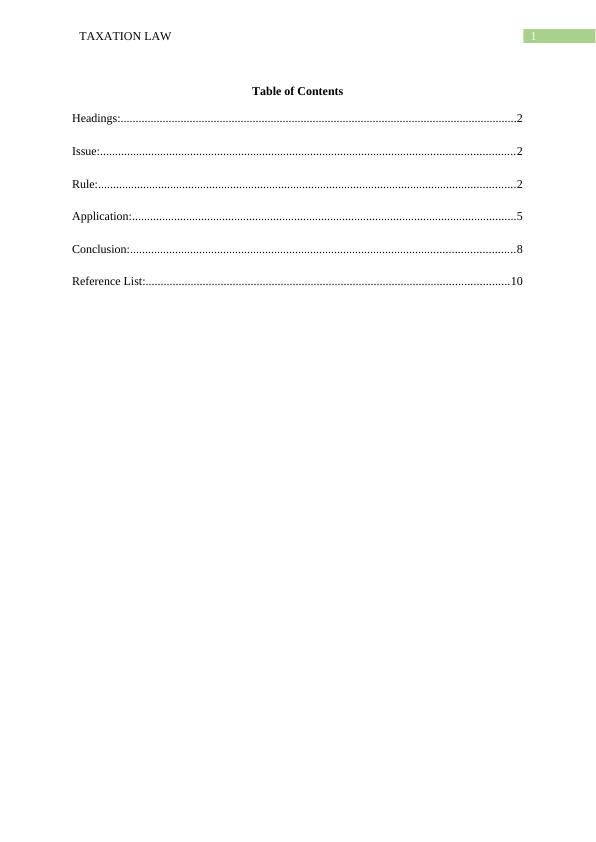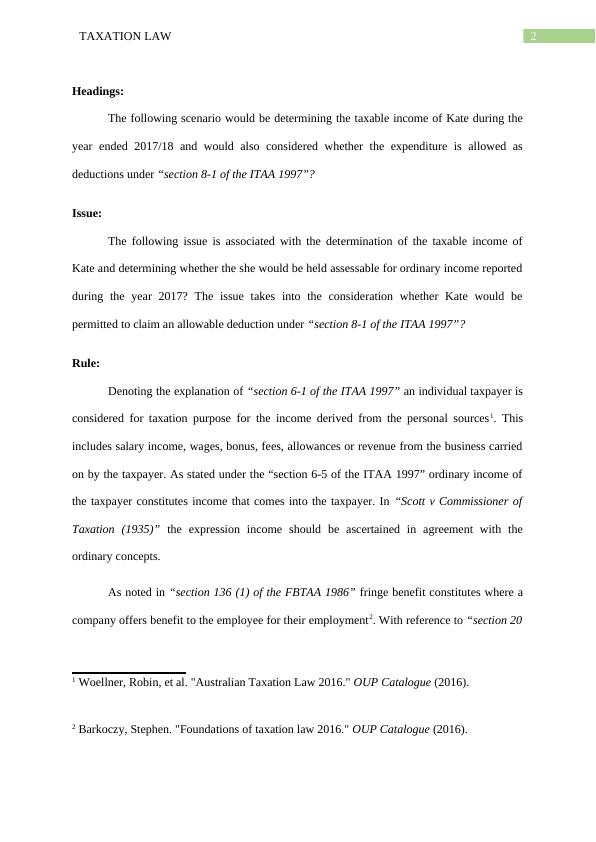Determining Taxable Income and Allowable Deductions under Taxation Law
Added on 2023-06-11
12 Pages2334 Words127 Views
Running head: TAXATION LAW
Taxation Law
Name of the Student
Name of the University
Authors Note
Course ID
Taxation Law
Name of the Student
Name of the University
Authors Note
Course ID

1TAXATION LAW
Table of Contents
Headings:....................................................................................................................................2
Issue:..........................................................................................................................................2
Rule:...........................................................................................................................................2
Application:................................................................................................................................5
Conclusion:................................................................................................................................8
Reference List:.........................................................................................................................10
Table of Contents
Headings:....................................................................................................................................2
Issue:..........................................................................................................................................2
Rule:...........................................................................................................................................2
Application:................................................................................................................................5
Conclusion:................................................................................................................................8
Reference List:.........................................................................................................................10

2TAXATION LAW
Headings:
The following scenario would be determining the taxable income of Kate during the
year ended 2017/18 and would also considered whether the expenditure is allowed as
deductions under “section 8-1 of the ITAA 1997”?
Issue:
The following issue is associated with the determination of the taxable income of
Kate and determining whether the she would be held assessable for ordinary income reported
during the year 2017? The issue takes into the consideration whether Kate would be
permitted to claim an allowable deduction under “section 8-1 of the ITAA 1997”?
Rule:
Denoting the explanation of “section 6-1 of the ITAA 1997” an individual taxpayer is
considered for taxation purpose for the income derived from the personal sources1. This
includes salary income, wages, bonus, fees, allowances or revenue from the business carried
on by the taxpayer. As stated under the “section 6-5 of the ITAA 1997” ordinary income of
the taxpayer constitutes income that comes into the taxpayer. In “Scott v Commissioner of
Taxation (1935)” the expression income should be ascertained in agreement with the
ordinary concepts.
As noted in “section 136 (1) of the FBTAA 1986” fringe benefit constitutes where a
company offers benefit to the employee for their employment2. With reference to “section 20
1 Woellner, Robin, et al. "Australian Taxation Law 2016." OUP Catalogue (2016).
2 Barkoczy, Stephen. "Foundations of taxation law 2016." OUP Catalogue (2016).
Headings:
The following scenario would be determining the taxable income of Kate during the
year ended 2017/18 and would also considered whether the expenditure is allowed as
deductions under “section 8-1 of the ITAA 1997”?
Issue:
The following issue is associated with the determination of the taxable income of
Kate and determining whether the she would be held assessable for ordinary income reported
during the year 2017? The issue takes into the consideration whether Kate would be
permitted to claim an allowable deduction under “section 8-1 of the ITAA 1997”?
Rule:
Denoting the explanation of “section 6-1 of the ITAA 1997” an individual taxpayer is
considered for taxation purpose for the income derived from the personal sources1. This
includes salary income, wages, bonus, fees, allowances or revenue from the business carried
on by the taxpayer. As stated under the “section 6-5 of the ITAA 1997” ordinary income of
the taxpayer constitutes income that comes into the taxpayer. In “Scott v Commissioner of
Taxation (1935)” the expression income should be ascertained in agreement with the
ordinary concepts.
As noted in “section 136 (1) of the FBTAA 1986” fringe benefit constitutes where a
company offers benefit to the employee for their employment2. With reference to “section 20
1 Woellner, Robin, et al. "Australian Taxation Law 2016." OUP Catalogue (2016).
2 Barkoczy, Stephen. "Foundations of taxation law 2016." OUP Catalogue (2016).

3TAXATION LAW
of the FBTAA 1986” expense fringe benefit occurs when the expenses of employee is paid by
employer.
Mere prizes are not treated as income. But the amount received from such prizes may
be treated as income when it holds sufficient nexus with the income producing activities of
the taxpayer. In “Kelly v FCT” the professional football player received award for being the
fair player3. The sum received by footballer constituted income as it was incidental to his
work and employment with club. According to “section 6-1 of the ITAA 1997” a taxpayer
obtaining income from personal exertion is included in taxable income as either ordinary or
statutory income. Mere prize wins is not an income but assessable if holds nexus with the
taxpayer’s income earning activities. In “FCT v Stone” the taxpayer received salary as
policewomen and earned prize money from sporting endorsement. According to
commissioner of taxation, the taxpayer was found to be executing the business of
professional athlete and the money received constituted income.
An individual receiving payments from sporting appearance or promotions that has
nexus with the income producing activities then such amount is considered taxable. In “Kelly
v FCT” receipt of payment by taxpayer for public appearance is chargeable earnings. As
stated in “subsection 108-10 (1) of the ITAA 1997” to work out the capital gains losses
obtained from selling collectibles should be only employed in lowering the gains from
collectibles. Collectibles are viewed as single assets under “section 108-15 (2) of the ITAA
1997” and selling of each set is held as portion of collectibles. Moreover, collectibles
purchased for less than $500 should be ignored4.
3 Basu, Subhajit. Global perspectives on e-commerce taxation law. Routledge, 2016.
4 Long, Brendan, Jon Campbell, and Carolyn Kelshaw. "The justice lens on taxation policy in
Australia." St Mark's Review235 (2016): 94.
of the FBTAA 1986” expense fringe benefit occurs when the expenses of employee is paid by
employer.
Mere prizes are not treated as income. But the amount received from such prizes may
be treated as income when it holds sufficient nexus with the income producing activities of
the taxpayer. In “Kelly v FCT” the professional football player received award for being the
fair player3. The sum received by footballer constituted income as it was incidental to his
work and employment with club. According to “section 6-1 of the ITAA 1997” a taxpayer
obtaining income from personal exertion is included in taxable income as either ordinary or
statutory income. Mere prize wins is not an income but assessable if holds nexus with the
taxpayer’s income earning activities. In “FCT v Stone” the taxpayer received salary as
policewomen and earned prize money from sporting endorsement. According to
commissioner of taxation, the taxpayer was found to be executing the business of
professional athlete and the money received constituted income.
An individual receiving payments from sporting appearance or promotions that has
nexus with the income producing activities then such amount is considered taxable. In “Kelly
v FCT” receipt of payment by taxpayer for public appearance is chargeable earnings. As
stated in “subsection 108-10 (1) of the ITAA 1997” to work out the capital gains losses
obtained from selling collectibles should be only employed in lowering the gains from
collectibles. Collectibles are viewed as single assets under “section 108-15 (2) of the ITAA
1997” and selling of each set is held as portion of collectibles. Moreover, collectibles
purchased for less than $500 should be ignored4.
3 Basu, Subhajit. Global perspectives on e-commerce taxation law. Routledge, 2016.
4 Long, Brendan, Jon Campbell, and Carolyn Kelshaw. "The justice lens on taxation policy in
Australia." St Mark's Review235 (2016): 94.

End of preview
Want to access all the pages? Upload your documents or become a member.
Related Documents
Taxation Law: Tax Determination of Kate for Income Year 2017-18lg...
|11
|2251
|162
Taxation Law: Understanding Tax Calculations and Deductions for Katelg...
|9
|1977
|303
Taxation Lawlg...
|13
|3165
|53
Taxation Law Application - Assignmentlg...
|10
|1592
|107
Taxation Law Application - PDFlg...
|11
|2169
|52
Taxation Lawlg...
|8
|2379
|85
